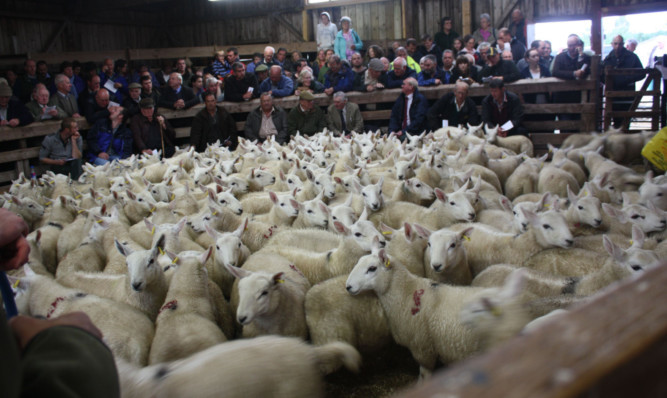Going by the results of the sale of North Country Cheviot lambs at Lairg it would seem there is some cautious confidence in the sheep sector.
Ewe lambs in particular were strongly bid for, with 5,187 averaging £67.50, up £7.54 on the year, and topping at £148 per head for a top draw of 30 from Alan MacKay, South Balkeith, Tain.
The 9,449 wethers forward averaged £55.41, up £2.17 on the year, and selling to a top price of £67.50 per head from Joyce Campbell, of Armadale, Caithness.
The total sold at 14,636 is on par with recent years but would have been slightly higher had all the lambs consigned made it through the floods.
One or two lots will need to wait for the next sale and more clement weather.
The general opinion was that the lambs were in good bloom this year and looked well despite having been wet for several days.
At least the sale in the venerable wooden mart at Lairg was held in good weather.
Regular Lairg buyer Jim Reid, Bengalhill, Lockerbie, was in action buying the 350-strong top wether draw from Auchentoul, Kinbrace, for £52.50, up 50p on the year.
He planned as usual to finish his Lairg lambs next March and April on stubble, turnips and silage.
Vendor Sir John Nutting and his shepherd Stuart Henderson were pleased with their trade, especially for their ewe lambs, which were up £12 on the year.
United Auctions chairman David Leggat noted between 10 and 15 buyers this year who were either new to Lairg or returning after several years’ absence. This could well explain the rise in ewe lamb prices, with some either building up numbers or starting new flocks to qualify as “active farmers” under the new CAP.
George Milne, development manager in Scotland for the National Sheep Association, was of the opinion most of the Lairg consignors would do reasonably well out of the new CAP.
“Most will be in Region 3, which covers the most remote areas. They are likely to receive 10 euros per hectare plus 100 euros of coupled payment for each ewe hogg.
“Some will see an increase in payments and some will be about the same,” he said.
Asked if the stocking densities would be sufficient to meet the active farmer test, Mr Milne thought they would be with the details of the so-called Scottish Clause on minimum stocking rates still to be agreed between Scottish Government and the EU.
“I am delighted to see that people like the consignors here today will at last be rewarded for sticking with their sheep. They are, after all, supporting their local economies,” he added.
Some of the hill farmers who had stopped keeping sheep under the old CAP regime had become “slipper farmers” simply collecting area-based Single Farm Payment without keeping sheep.
Mr Milne thought some might reinstate their flocks.
“It will be hard, though.
“They would need firstly to find shepherds and then they would need to heft the sheep back on to these unfenced hills,” he said.
Top prices:
Ewe lambs (5,187): Alan Mackay, South Balkeith, £148; Joyce Campbell, Armadale £112; DA Henderson, 13 Inverbrackie, £100.
Wether lambs (9,449): Joyce Campbell £67.50; DA Henderson £65.50; Alan MacKay £62; H McKenzie, Tulloch, Bonar Bridge £62.
